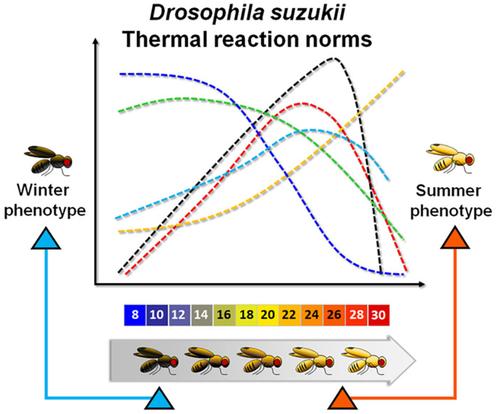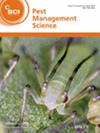求助PDF
{"title":"苏氏果蝇表面上的季节性双态性实际上源于连续的反应规范。","authors":"Hervé Colinet, Alexiane Kustre","doi":"10.1002/ps.8452","DOIUrl":null,"url":null,"abstract":"<p><p>The spotted wing drosophila (SWD) is supposed to show only two distinct seasonal phenotypes: the dark, diapausing winter morph (WM) and the light, reproductively active summer morph (SM). It is unclear if these phenotypes result from a true developmental switch or from the expression of extreme phenotypes of continuous thermal reaction norms. This study aims to investigate this question by examining traits across a range of temperatures. Using 12 developmental temperatures (8 to 30 °C), we assessed traits including viability, growth, morphology, cold tolerance, metabolic rate, and ovarian maturation. Gradual increases in temperature induced gradual changes in all these traits, indicating classical nonlinear thermal reaction norms. Low temperatures (14 °C and below) produced flies with extended development, dark color, larger size, increased cold tolerance, reduced metabolism, and delayed oogenesis, characteristic of the WM. Given the months required for emergence and egg maturation at cold, distinct generations of SWD may develop in discrete environments resulting in an apparent biphenism. What appears to be distinct phenotypes (WM and SM) may actually result from continuous thermal reaction norms. This implies the need for precise terminology in SWD. We recommend using terms like 'winter-acclimated' or 'winter phenotype' rather than 'winter morph'. © 2024 The Author(s). Pest Management Science published by John Wiley & Sons Ltd on behalf of Society of Chemical Industry.</p>","PeriodicalId":218,"journal":{"name":"Pest Management Science","volume":" ","pages":""},"PeriodicalIF":3.8000,"publicationDate":"2024-10-03","publicationTypes":"Journal Article","fieldsOfStudy":null,"isOpenAccess":false,"openAccessPdf":"","citationCount":"0","resultStr":"{\"title\":\"The apparent seasonal biphenism in Drosophila suzukii stems in reality from continuous reaction norms.\",\"authors\":\"Hervé Colinet, Alexiane Kustre\",\"doi\":\"10.1002/ps.8452\",\"DOIUrl\":null,\"url\":null,\"abstract\":\"<p><p>The spotted wing drosophila (SWD) is supposed to show only two distinct seasonal phenotypes: the dark, diapausing winter morph (WM) and the light, reproductively active summer morph (SM). It is unclear if these phenotypes result from a true developmental switch or from the expression of extreme phenotypes of continuous thermal reaction norms. This study aims to investigate this question by examining traits across a range of temperatures. Using 12 developmental temperatures (8 to 30 °C), we assessed traits including viability, growth, morphology, cold tolerance, metabolic rate, and ovarian maturation. Gradual increases in temperature induced gradual changes in all these traits, indicating classical nonlinear thermal reaction norms. Low temperatures (14 °C and below) produced flies with extended development, dark color, larger size, increased cold tolerance, reduced metabolism, and delayed oogenesis, characteristic of the WM. Given the months required for emergence and egg maturation at cold, distinct generations of SWD may develop in discrete environments resulting in an apparent biphenism. What appears to be distinct phenotypes (WM and SM) may actually result from continuous thermal reaction norms. This implies the need for precise terminology in SWD. We recommend using terms like 'winter-acclimated' or 'winter phenotype' rather than 'winter morph'. © 2024 The Author(s). Pest Management Science published by John Wiley & Sons Ltd on behalf of Society of Chemical Industry.</p>\",\"PeriodicalId\":218,\"journal\":{\"name\":\"Pest Management Science\",\"volume\":\" \",\"pages\":\"\"},\"PeriodicalIF\":3.8000,\"publicationDate\":\"2024-10-03\",\"publicationTypes\":\"Journal Article\",\"fieldsOfStudy\":null,\"isOpenAccess\":false,\"openAccessPdf\":\"\",\"citationCount\":\"0\",\"resultStr\":null,\"platform\":\"Semanticscholar\",\"paperid\":null,\"PeriodicalName\":\"Pest Management Science\",\"FirstCategoryId\":\"97\",\"ListUrlMain\":\"https://doi.org/10.1002/ps.8452\",\"RegionNum\":1,\"RegionCategory\":\"农林科学\",\"ArticlePicture\":[],\"TitleCN\":null,\"AbstractTextCN\":null,\"PMCID\":null,\"EPubDate\":\"\",\"PubModel\":\"\",\"JCR\":\"Q1\",\"JCRName\":\"AGRONOMY\",\"Score\":null,\"Total\":0}","platform":"Semanticscholar","paperid":null,"PeriodicalName":"Pest Management Science","FirstCategoryId":"97","ListUrlMain":"https://doi.org/10.1002/ps.8452","RegionNum":1,"RegionCategory":"农林科学","ArticlePicture":[],"TitleCN":null,"AbstractTextCN":null,"PMCID":null,"EPubDate":"","PubModel":"","JCR":"Q1","JCRName":"AGRONOMY","Score":null,"Total":0}
引用次数: 0
引用
批量引用



